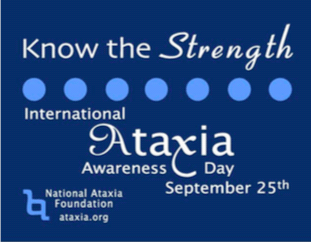September 25 Designated International Ataxia Awareness Day (IAAD)

The Minneapolis, Minnesota based National Ataxia Foundation and Ataxia organizations around the world have dedicated September 25, 2015 as the 16th annual International Ataxia Awareness Day (IAAD) help raise awareness about ataxia.
Most people have likely never heard of ataxia, which refers to a group of rare and often fatal genetically-based degenerative neurological disorders. An estimated 150,000 people in the United States are affected by ataxia.
Ataxia symptoms are progressive and often impact coordination, hearing, vision, and speech. The disease affects both genders and all ages, but too often strikes children and young adults.
The word “ataxia”, comes from the Greek word, ” a taxis” meaning “without order or incoordination”. People with ataxia have problems with coordination because parts of the nervous system that control movement and balance are affected. Ataxia may affect the fingers, hands, arms, legs, body, speech, and eye movements. The word ataxia is often used to describe a symptom of incoordination which can be associated with infections, injuries, other diseases, or degenerative changes in the central nervous system. Ataxia is also used to denote a group of specific degenerative diseases of the nervous system called the hereditary and sporadic ataxias which are the National Ataxia Foundation’s primary emphases.Diagnosis of ataxia is based on a person’s medical history, family history, and a complete neurological evaluation including an MRI scan of the brain. Various blood tests may be performed to rule out other possible disorders which may present similar symptoms. Genetic blood tests are now available for some types of hereditary ataxia to confirm a diagnosis or as a predictive test to determine if someone has inherited an ataxia gene known to affect other family members. At this time, there is no effective treatment or cure for ataxia.
“The National Ataxia Foundation was established in 1957 and is dedicated in serving ataxia families through research, education, and support services,” says Michael Parent, the National Ataxia Foundation’s Executive Director. “Ataxia can affect anyone at any time and is caused by either a recessive or dominant gene. There are also sporadic forms of ataxia which have no known genetic link or family history.”
International Ataxia Awareness Day has grown over the years, and more ideas keep coming in. Each country, state, or individual participating in International Ataxia Awareness Day may have a specific plan for the event. The goal of IAAD is for every individual to participate in some activity, creating awareness about ataxia, perhaps sharing knowledge about ataxia with at least one other person who has never heard of it, educating a group of people by speaking at a school or civic group, contacting the media, or raising financial support.
The hereditary ataxias are genetic, that is caused by a defect in a certain gene that is present from the start of a person’s life. A The hereditary ataxias can be divided into those that are dominantly inherited and those that are recessively inherited. Autosomal dominant inheritance refers to a genetic pattern where the gene that causes the ataxia is located on one of the autosomes and will affect males and females equally. An autosome is any of the chromosomes that are not sex chromosomes. All genes come in pairs and dominantly inherited means that the gene with the disease mutation dominates over the normal copy of the gene.
Autosomal recessive inherited diseases also affect males and females equally but it takes a “double dose” of the ataxia gene to result in disease symptoms. Both parents must be carriers of the disease gene and each must pass on the ataxia gene to their child for the double dose that is needed to produce symptoms of the recessive disease. In the dominant forms of ataxia, each child born has a 50/50 chance of developing the disorder. In the case of recessive forms, each child born has a 25 percent chance of being affected, a 50 percent chance of being a carrier, and only a 25 percent chance of not being affected or a carrier of the gene. In the recessive forms of ataxia, many times people do not know that they carry an ataxia gene until their child begins to display signs of incoordination.
The first ataxia gene was identified in 1993 for a dominantly inherited type, and called “Spinocerebellar Ataxia type1 (SCA1)”. Subsequently, as additional dominant genes were found they were called SCA2, SCA3, etc. Generally the number behind the SCA refers to the order in which the gene was found. At this time, 36 different gene mutations have been found. In other words, there are have dominant ataxia classifications from SCA1 to SCA 36. Genes have also been located for some of the recessive ataxias, the most common being Friedreich’s ataxia (FRDA) but also Ataxia with Oculomotor Apraxia Type 1 and Type 2 (AOA1 and AOA2).
A characteristic that the various abnormal genes that cause ataxia have in common is that they make abnormal proteins that affect nerve cells, primarily in the cerebellum (and other parts of the brain) and the spinal cord. Details of which parts of the nervous system are most affected vary with the different types of ataxia. All forms of ataxia cause poor coordination but some forms also cause additional symptoms that make it easier to distinguish one from the other.
Ataxia Symptoms And Etiology
Symptoms and time of onset vary according to the type of ataxia, and there are often variations even within the same family with the same type of ataxia. Recessive disorders commonly cause symptoms to begin in childhood rather than adulthood. However, in recent years since genetic testing became available, it is now known the Friedreich’s ataxia has an adult onset on some occasions. Dominant ataxia often begins in the 20s or 30s or even later in life. Sometimes individuals may not show symptoms until they are in their 60s.
Eventually affected nerve cells begin to function poorly and ultimately degenerate. As the disease progresses, muscles become less and less responsive to commands from the brain, causing coordination problems to become more pronounced. Typically balance and coordination are affected first. In coordination of hands, arms, and legs, and slurring of speech are other common symptoms. Walking becomes difficult and is characterized by walking with feet placed further apart to compensate for poor balance. Impaired coordination of the arms and hands affect a person’s ability to perform tasks requiring fine motor control such as writing and eating. Slow eye movements can be seen in some form of ataxia. As time goes on, ataxia can affect speech and swallowing.
The hereditary ataxias are degenerative disorders that progress over a number of years. How severe the disability will become and whether the disease will lead to death depends on type of ataxia, the age of onset of symptoms and other factors that are poorly understood at this time. Respiratory complications can be fatal in a person who is bed bound or who has severe swallowing problems. Some persons with Friedreich’s ataxia develop serious cardiac problems.
There is also a large group of people who have symptoms of ataxia that usually begin in adulthood and who have no known family history of this disease. This is called sporadic ataxia and it can be difficult to diagnose. There are many acquired and hereditary causes of ataxia which must be ruled out before a diagnosis of sporadic ataxia can be made. Sporadic ataxia can be either “pure cerebellar” if only the cerebellum is affected or cerebellar plus, if the ataxia is accompanied by additional symptoms such a neuropathy (dysfunction of the peripheral nerves); dementia (impaired intellectual function); or weakness, rigidity, or spasticity of the muscles. Disability may be greater and progress more quickly with the cerebellar plus form of sporadic ataxia. The cerebellar plus form of sporadic ataxia is also known as sporadic olivopontocerebellar ataxia ( sporadic OPCA) or multiple system atrophy, cerebellar type (MSA-C).
To find out more about ataxia and International Ataxia Awareness Day, visit the National Ataxia Foundation’s website at:
https://www.ataxia.org
You can also write the Foundation at 2600 Fernbrook Lane, Suite 119, Minneapolis, MN 55447-4752, email at [email protected], or call (763) 553-0020.
Sources:
The National Ataxia Foundation
Image Credits:
The National Ataxia Foundation






